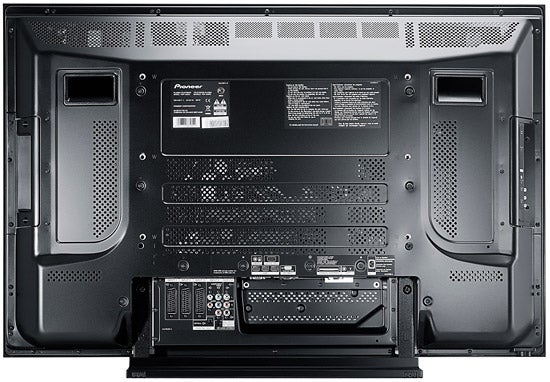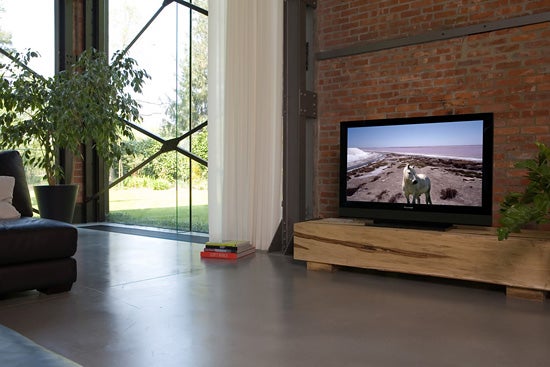Pioneer KURO PDP-428XD 42in Plasma TV Review
Pioneer KURO PDP-428XD 42in Plasma TV
Pioneer continues to show that its Kuro plasma screens are the new black.

Verdict
Key Specifications
- Review Price: £1517.00
More often than not, when you find an electronics brand boasting about one of their products having the ‘world’s best this’ or the ‘universe’s best that’, it turns out to be nothing more than meaningless posturing supported by dubious measurements. But with Pioneer’s KURO TVs the situation is rather different.
For Pioneer claims that its new plasma TV range produces the best black level response the flat TV world has ever seen not only appear to be true, but they’re true by a striking margin.
We know this because we’ve already tested and been seduced by Pioneer’s latest 50in model, the KURO PDP-508XD. But with that model being rather intimidating in terms of both its size and cost (you’ll struggle to find it selling for south of £2,300), we thought you’d appreciate it if we ran our eye over the 42in version too, with its more living room-friendly 8in size reduction and bank balance-friendly £500 cheaper price tag.
Aesthetically the 428XD is a ringer for its larger sibling – and that’s no bad thing, for the quality of the glossy, minimal black finish is impressively opulent and refined. If you’ve paid a premium for a TV, you really want it to immediately say ‘expensive’ to anyone who clocks it and that’s exactly what the 428XD does.
It’s also ahead of the vast majority of the current 42in pack when it comes to connections. For starters, there are three HDMIs, all equipped with 1080p/24fps support, and all allowing the TV’s remote to operate any source equipment connected to them – provided that source equipment is compatible with the industry’s CEC interoperability standard.
Plus there are all the usual bits and bobs associated with a TV digital tuner; a D-Sub PC port; a subwoofer line-out; a digital audio output for passing on digital soundtracks received via the HDMIs; an RS-232 port via which an Imaging Science Foundation engineer could calibrate your TV’s pictures to perfectly suit the demands of your room; and a USB 2.0 input for viewing digital stills in glorious high definition via Pioneer’s unusually comprehensive Home Gallery software. This is all on top, of course, of basic TV stalwarts like SCARTs, S-Video inputs and the like.
The already premium feel the 428XD has developed so far is merely enhanced by its long and exceptionally comprehensive list of features. We won’t bore you with a huge list of absolutely everything the set carries, but there are certainly some highlights that we really can’t ignore.
Not least among the highlights is a mode in the onscreen menus that allows you to adjust the TV’s frequency to 72Hz. This allows the TV to show the pure 1080p/24fps feeds now delivered by some Blu-ray players (including Pioneer’s own BDP-LX70) using a relatively simple 3:3 pulldown system. This hopefully results in 1080p/24 playback that looks cleaner and smoother than you’d expect with the more complicated calculations required to reproduce 24fps on less adaptable screens.
Given the importance of the 428XD’s black level performance, it’s also worth quickly outlining the innovations Pioneer has introduced to make this happen. There are five main ones. Number one is new glass in the plasma panel, driven by completely new address circuitry. Two is the use of deep-set plasma chambers – in a structure dubbed the Deep Waffle Rib – to reduce cross-light and cross-colour seepage between pixels.
Third is an improved version of Pioneer’s Deep Colour Filter system, which integrates into the screen in place of the usual thick plasma glass and reduces the amount of reflections on the screen.
Fourth is brand new image processing that applies entirely different techniques for dark and light scenes. And last but certainly not least is the latest version of Pioneer’s crystal emissive layer; a layer sandwiched between the plasma glass and the individual light cells which not only improves luminance efficiency, but also enhances the efficiency of the plasma discharge cycle so that pixels can go from pure white to deep black and back again faster.
The result of all this black level obsession is a class-leading claimed contrast ratio of 16,000:1 – though as with the 50in KURO, we have to say that our experience of actually watching the 428XD suggests that this figure is in reality quite conservative.
Take, for instance, the highly stylised, extremely contrasted images of the battles in 300 on HD DVD or Blu-ray. Essentially no other 42in TV that’s come through our doors before has ever managed to produce black levels as deep, natural, and packed with subtle detailing as this Pioneer.
What’s more, as well as helping you clearly detect every last pixel of detail in the impressive 300 transfer in a way just not possible with typical flat screens (where dark areas are masked behind a wall of greyness) the black level depth here gives the picture a truly cinematic dynamism.
Not that this dynamism is restricted to great black level depth. For the 428XD also produces a remarkably vibrant, rich, solid but also completely natural palette of colours that delivers a perfect counterpoint to the immaculate blacks. Indeed, the overwhelming naturalism of the 428XD’s pictures gives us a salutary reminder of the fact that you really can’t expect a totally natural colourscape from any flat TV that doesn’t have superb black levels.
Perhaps the biggest surprise about the 428XD is how sharp and clean its pictures look. This is not a full HD screen – indeed, its 1,024 x 768 native resolution clearly entails some heavy rescaling of an HD source. Yet the processing engine driving the TV is so accomplished that HD pictures actually tend to look cleaner and sharper than with many full HD TVs – especially models that use LCD rather than plasma technology. Standard definition pictures hold up well, too.
Yet more praise deserves to be heaped on the 428XD’s motion handling. We’re familiar with plasma’s naturally faster response time causing less motion blur than LCD screens, but the clarity and smoothness of the 428XD’s presentation of moving objects still catches your eye – especially when using the 72Hz mode to show 1080p/24fps, a format that many rival screens struggle with.
Furthermore, there’s practically no sign of traditional plasma technology problems. For instance, the common fizzing over motion is almost completely suppressed. And the customary ‘secondary imaging’ if you watch from off axis is non-existent thanks to the 428XD’s replacement of plasma’s traditional thick glass with a narrow single colour filter technology.
With really nothing bad to say about the 428XD’s pictures, perhaps we can find fault with the TV’s speakers? Um, no, ‘fraid not. In fact the speakers are terrifically powerful by TV standards, pushing out power galore together with near hi-fi levels of clarity and detailing.
”’Verdict”’
The very worst thing that can be said about the 428XD is that its overall impact isn’t quite as great as that of the 508XD. But we only say this because picture quality this good just looks better the bigger the screen you see it on; there’s nothing actually wrong with the 428XD. Far from it. In fact, if a 42in screen size or £1,600 represent your maximum extent of your TV ambition, the 428XD will deliver the goods more successfully than any other flat TV range before.

How we test televisions
We test every TV we review thoroughly over an extended period of time. We use industry standard tests to compare features properly. We’ll always tell you what we find. We never, ever, accept money to review a product.
Trusted Score
Score in detail
-
Value 8
-
Image Quality 10
-
Sound Quality 10

